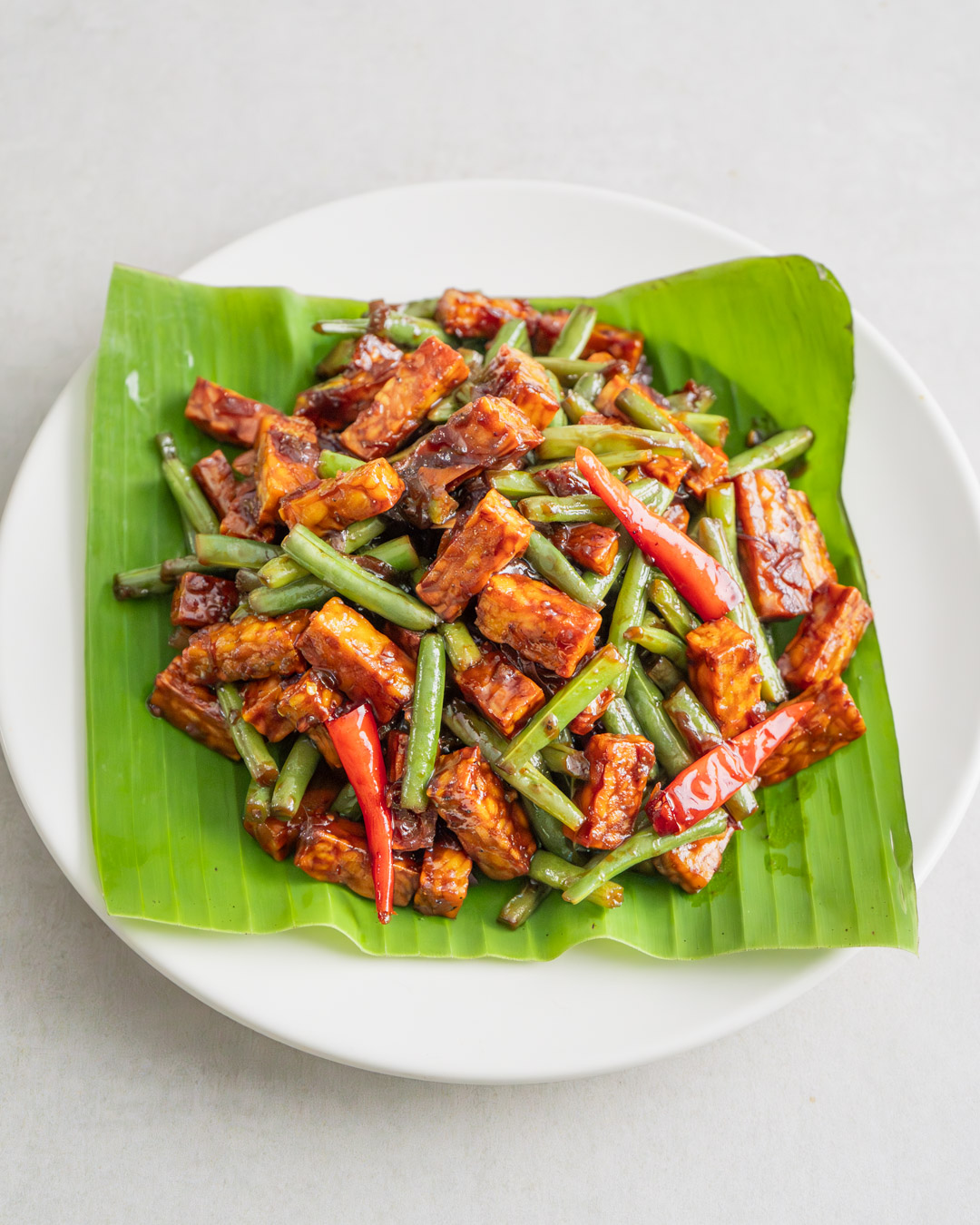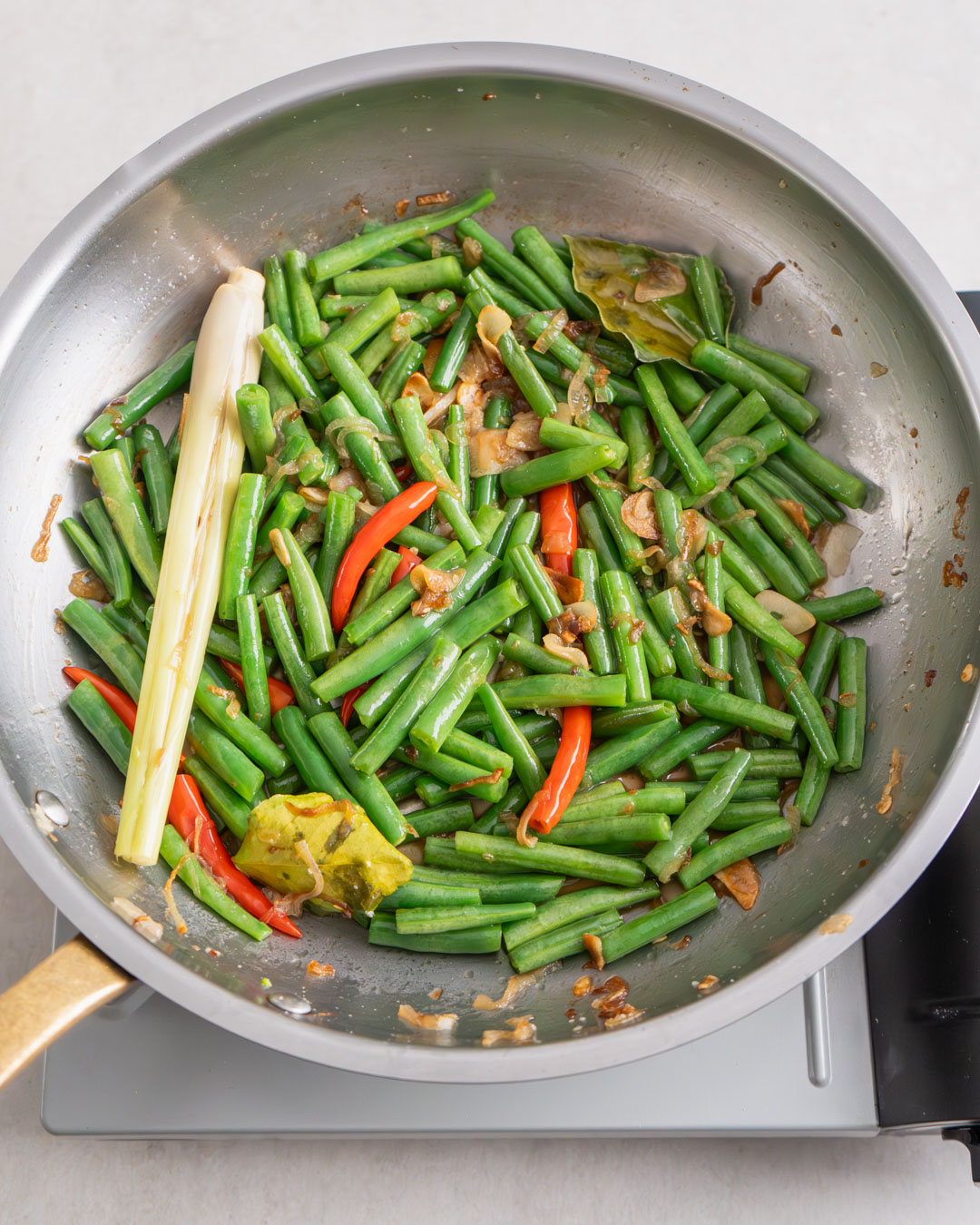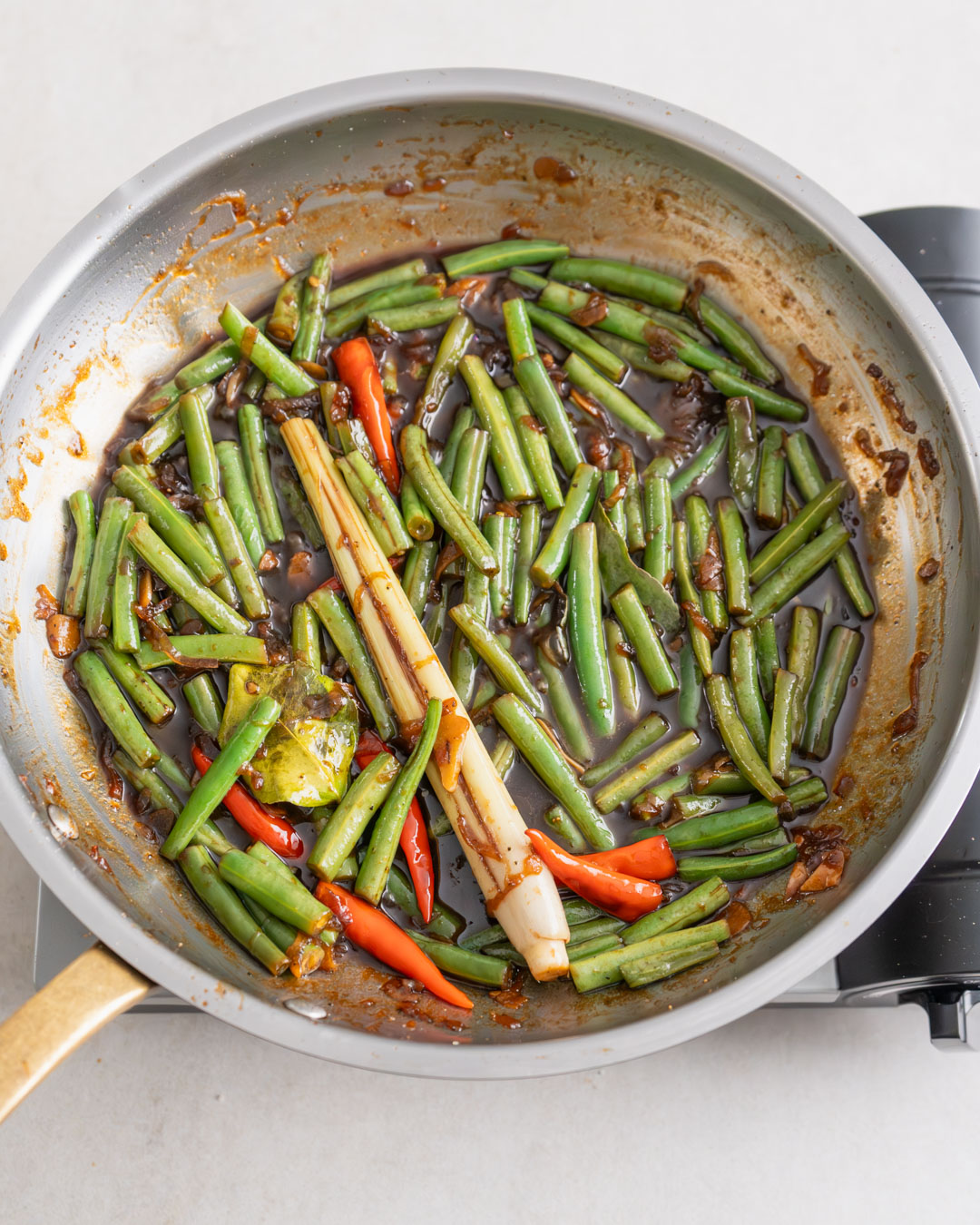Bean Tempe Orek (Indonesian Tempeh with Beans)

You might know tempeh as a key ingredient in modern vegan cooking, but have you ever wondered how it is traditionally eaten? Indonesian Bean Tempe Orek is the perfect example.
What is Bean Tempe Orek?
Bean Tempe Orek is a delicious and satisfying Indonesian dish that combines tempeh—fermented soybeans—with beans, stir-fried in a flavorful blend of sweet and spicy seasonings. It is traditionally vegan and packed with protein and fiber. Usually, the tempeh is deep-fried, before it is combined with the aromatic stir-fry. However, I prefer roasting it in the oven to make the recipe slightly more accessible.
History of Bean Tempe Orek
Tempeh itself has ancient roots in Java, Indonesia. It is thought to date back several centuries, with records of its production and consumption appearing as early as the 16th century. Tempeh was historically a byproduct of tofu production, where discarded soy pulp would ferment naturally. Over time, locals refined the fermentation process to create the distinct cake-like form of tempeh we know today.
Tempeh became a staple in Javanese diets due to its affordability, nutritional value, and ability to mimic meat textures, making it accessible to lower-income communities. As a plant-based protein source, it played a crucial role in vegetarian diets associated with Hindu-Buddhist traditions in Java.
“Orek” refers to a cooking technique in Indonesian cuisine that involves stir-frying or sautéing with seasonings. Tempe Orek likely emerged as a practical way to enhance the flavor of tempeh by combining it with aromatics, such as garlic, shallots, and chilies, as well as sweet soy sauce (kecap manis)—a key ingredient in Indonesian cooking.
Ingredients You’ll Need to Make Bean Tempe Orek + Substitutions
- Seedless Tamarind: For the tangy, sour base of the dish. You can use ready-made tamarind paste, or substitute with lime juice for a different, but also tangy flavour.
- Tempeh: A protein-packed ingredient made from fermented soybeans and the substance of this dish. You can use tofu instead for a stir-fried tofu & bean dish.
- Groundnut Oil: Typically used for stir-frying, groundnut oil has a neutral flavor. You can use other neutral oils like vegetable oil.
- Round Shallots: Shallots are essential for their subtle sweetness. Substitute with a smaller amount of onions or green onions.
- Garlic: Fresh garlic cloves add aromatic depth to the stir-fry.
- Red Bird’s Eye Chilies: These small, spicy chilies provide the heat in the dish. Adjust the number of chilies to your spice tolerance.
- Green Beans: Green beans are typically used in this recipe for crunch and color. You can use other beans or vegetables, such as snap peas or snow peas, as a substitute.
- Lemongrass: Lemongrass imparts a fragrant citrusy flavor to the dish, but is optional.
- Makrut Lime Leaves: These leaves provide a unique, aromatic citrus flavor. You could also use frozen leaves, or leave them out.
- Kecap Manis: This sweet soy sauce is essential for the dish’s sweet, savory flavor. If you don’t have kecap manis, mix regular soy sauce with brown sugar (2 parts soy sauce to 1 part sugar) as a quick substitute.
- Palm Sugar: Used for sweetness and to balance the heat, palm sugar adds a caramel-like flavor. If you can’t find palm sugar, brown sugar is a good alternative.
- Freshly Ground Black Pepper: Adds a mild heat and depth to the dish.
How to Make Bean Tempe Orek (Step-by-Step)
Preheat the Oven and Prepare Baking Tray. Preheat the oven to 220°C (200°C fan). Line a baking tray with parchment paper to prevent the tempeh from sticking. Instead of roasting, you can also deep-fry the tempeh, which is the traditional way. If serving this with rice, start cooking it now.
Prepare Tamarind. If using seedless tamarind, soak it in 100ml of boiling water for 15 minutes to soften it. Once it has cooled enough to handle, use your fingers to loosen the tamarind flesh from the fibrous strings. Strain the liquid through a fine sieve into a small bowl, discarding the pulp.
Prepare the Tempeh. Cut the tempeh into 1cm-wide pieces and place them in a bowl. Add 2 tablespoons of groundnut oil to the bowl and toss to coat the tempeh evenly. Spread the tempeh pieces out on the prepared baking tray.

Roast in the preheated oven for about 15 minutes, or until golden and crispy on the edges.

Prepare the Aromatics and Vegetables. While the tempeh is roasting, peel and halve the shallots, then thinly slice them. Peel the garlic cloves and thinly slice them as well. Trim the bird’s eye chilies and set them aside. Trim the green beans and cut them into 4cm pieces. Bruise the lemongrass with a rolling pin to open up the fibers, allowing it to release its aroma.
Cook the Aromatics. Heat the remaining 3 tablespoons of oil in a large frying pan over medium-high heat. Add the shallots, garlic, chilies, and lime leaves to the pan and sauté for 1-2 minutes, or until the garlic begins to turn golden and fragrant.

Sauté the Beans. Add the green beans and bruised lemongrass to the pan, along with the salt. Reduce the heat and continue sautéing for another minute. Add around 50ml of water to the pan to deglaze and help steam the beans. Cook for 1-2 minutes, or until the water has evaporated.

Add the Tamarind and Sauce Ingredients. Add the tamarind water (or dissolved tamarind paste), kecap manis, palm sugar, and freshly ground black pepper to the pan. Stir to combine and cook for a few more minutes, allowing the sugar to melt and the sauce to bubble and thicken.

Combine Tempeh and Finish Cooking. Add the tempeh to the pan. Stir gently to coat the tempeh evenly in the sauce, making sure everything is well-glazed.
Serve. Discard the lemongrass and lime leaves from the pan, then divide the Bean Tempe Orek evenly between plates and serve with rice.
Useful Tips
- Adjust spice levels to your taste: The Bean Tempe Orek can be made as spicy or mild as you prefer by adding less or more chillies. Bird’s eye chillies are quite spicy to begin with, so you can also use other varieties for a milder heat. Even dried chillis will work to impart a subtle warmth.
- Balance the sauce if it’s too salty: Kecap manis (sweet soy sauce) can be quite salty, depending on the brand. If the sauce tastes too salty, add a splash of lime juice or acidity to balance it out.
- Use a bit of water to steam the beans: Adding a splash of water after sautéing the green beans helps to cook them through without burning and makes them tender yet crisp.
- Serve with rice: To turn it into a wholesome main, rather than a side, serve it with rice.
Why You’ll Love This Recipe
- naturally vegan
- hearty and nutritious
- a balance of sweet, spicy and savory
- packed with protein
How to Store Bean Tempe Orek
Store your leftover Bean Tempe Orek in an airtight container in the refrigerator for up to 3-4 days. When you’re ready to reheat, simply stir-fry it in a pan for a few minutes until warmed through. If you want to store it longer, you can freeze the dish for up to a month. To reheat frozen Bean Tempe Orek, thaw it overnight in the refrigerator and reheat as desired. Note that the beans may soften a bit after freezing, but the flavor will still be delicious.
**I receive a small commission from affiliate links on this page**

Bean Tempe Orek (Stir-Fried Sweet and Spicy Tempeh with Beans)
Ingredients
- 30 g seedless tamarind (or 30g tamarind paste dissolved in 70ml water water)
- 400 g tempeh
- 5 tbsp groundnut oil
- 4 round shallots (80g)
- 4 large garlic cloves
- 8 red bird’s eye chillies
- 300 g green beans
- 1 stick lemongrass
- 2 makrut lime leaves
- 1 tsp salt (7g)
- 4 tbsp kecap manis (60g)
- 1/2 tbsp palm sugar (15g), or brown sugar
- 1/2 tsp freshly ground black pepper
Instructions
- Pre-heat the oven to 220 °C (428 °F) (200 °C (392 °F) fan) and line a baking tray with parchment paper. Instead of roasting, you can also deep-fry the tempeh, which is the traditional way. If serving this with rice, start cooking it now.
- If using seedless tamarind, soak it in 100ml boiling water for 15 minutes. When cool enough to handle, use your fingers to loosen the flesh from the fibrous strings. Strain the liquid through a fine sieve into a small bowl and discard the pulp.
- Cut the tempeh into 1cm-wide pieces, add to a bowl with 2 tablespoons of the oil and toss to mix. Then spread them out on the baking tray and roast for 15 minutes or until golden.
- Meanwhile, peel, half and thinly slice the shallots; peel and thinly slice the garlic; trim the chillies; trim and cut the beans into 4 cm pieces; bruise the lemongrass with a rolling pin to open the fibres.
- Heat the remaining 3 tablespoons of oil in a frying pan over medium-high heat, then sauté the shallots, garlic, chillies and lime leaves until the garlic begins to turn golden (1-2 minutes). Add the green beans, lemongrass and salt, reduce the heat and continue sautéing for a minute, then add around 50ml of water to break the frying and steam the beans. Cook until the water has evaporated (1-2 minutes), then add the tamarind water (or dissolved paste), kecap manis, palm sugar and black pepper and continue cooking until the sugar has melted and the sauce begins to bubble all over. Add the tempeh and stir until everything is evenly glazed.
- Discard the lemongrass and lime leaves, then divide everything between plates and serve as a side or alongside rice as a main.


I made half a recipe of this with my homemade tempeh, and it was quite satisfying and interesting! Lots of flavors going on that work well with the earthy, nutty flavor of tempeh. Definitely gonna make this again. P.S. I don’t know if you grant wishes, but I’d like to see your take on mujaddara or koshari some time in the future. 🙂
I’m glad you liked it! ☺️ Of course! Mujaddara will be in my cookbook. Koshari is a great idea!